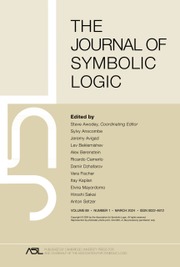No CrossRef data available.
Article contents
A WALK ON THE WILD SIDE: NOTIONS OF MAXIMALITY IN FIRST-ORDER THEORIES
Published online by Cambridge University Press: 13 June 2025
Abstract
In the classification of complete first-order theories, many dividing lines have been defined in order to understand the complexity and the behavior of some classes of theories. In this paper, using the concept of patterns of consistency and inconsistency, we describe a general framework to study dividing lines and introduce a notion of maximal complexity by requesting the presence of all the exhibitable patterns of definable sets. Weakening this notion, we define new properties (Positive Maximality and the  $\mathrm {PM}^{(k)}$ hierarchy) and prove some results about them. In particular, we show that
$\mathrm {PM}^{(k)}$ hierarchy) and prove some results about them. In particular, we show that  $\mathrm {PM}^{(k+1)}$ theories are not k-dependent. Moreover, we provide an example of a
$\mathrm {PM}^{(k+1)}$ theories are not k-dependent. Moreover, we provide an example of a  $\mathrm {PM}$ but
$\mathrm {PM}$ but  $\mathrm {NSOP}_4$ theory (showing that
$\mathrm {NSOP}_4$ theory (showing that  $\mathrm {SOP}$ and the
$\mathrm {SOP}$ and the  $\mathrm {SOP}_n$ hierarchy, for
$\mathrm {SOP}_n$ hierarchy, for  $n \geq 4$, cannot be described by positive patterns) and, for each
$n \geq 4$, cannot be described by positive patterns) and, for each  $1<k<\omega $, an example of a
$1<k<\omega $, an example of a  $\mathrm {PM}^{(k)}$ but
$\mathrm {PM}^{(k)}$ but  $\mathrm {NPM}^{(k+1)}$ theory (showing that the newly defined hierarchy does not collapse).
$\mathrm {NPM}^{(k+1)}$ theory (showing that the newly defined hierarchy does not collapse).
MSC classification
Information
- Type
- Article
- Information
- Copyright
- © The Author(s), 2025. Published by Cambridge University Press on behalf of The Association for Symbolic Logic


